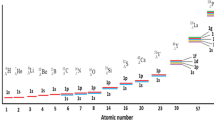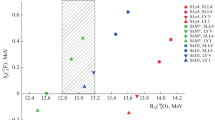Summary
The possibility of determining the spin dependence of the Λ-nucleon force from a study of hypernuclei in which the Λ particle is bound to a nucleus with an incompletely filled (1p) nuclear shell is investigated. It is pointed out that present uncertainties in the data on binding energies of hypernuclei permit only the determination of the combinationE s+3E t, whereE s andE t are the singlet and triplet interaction energies, respectively. It is shown that the decay of hypernuclei by π− emission can give information regarding the spin dependence of the force if the branching ratio for decay to the ground state and first excited state of the daughter nucleus is measured. In particular, if the spin of12BΛ is 2, decay to the first excited state of12C is favored by a factor 1.2 over decay to the ground level. However, ifJ=1 for this hypernucleus, decay to the ground state is preferred by a factor of 2.4. The change that the interaction of the π−-meson with the12C nucleus produces in the branching ratio is estimated by use of a complex square well potential. Inclusion of the interaction significantly increases the branching ratio for a hypernuclear spin of 2, but does not change the ratio forJ=1. On the other hand, for7LiΛ the branching ratio for decay to the ground and first excited state of7Be is independent of the spin of hypernucleus.
Riassunto
Si studia la possibilità di determinare la dipendenza della forza del nucleone Λ con uno studio degli ipernuclei in cui la particella Λ è legata ad un nucleo avente un livello nucleare incompleto (1p). Si sottolinea che le attuali incertezze sui dati delle energie di legame degli ipernuclei permettono solo la determinazione della combinazioneE s+3E t, in cuiE s edE t sono le energie di interazione del singoletto e del tripletto, rispettivamente. Si mostra che il decadimento degli ipernuclei con emissione π− può fornire informazioni sulla dipendenza della forza dallo spin se viene misurato il rapporto di branching per il decadimento allo stato fondamentale ed al primo stato eccitato del nucleo derivato. In particolare, se lo spin del12BΛ è 2, il decadimento al primo stato eccitato del12C è favorito per un fattore 1.2 rispetto al decadimento allo stato fondamentale. Però, seJ=1 per questo ipernucleo, il decadimento allo stato fondamentale viene favorito per un fattore 2.4. Il cambiamento che l’interazione del mesone π− col nucleo12C produce nel rapporto di branching viene stimato usando un pozzo di potenziale quadrato complesso. L’inclusione dell’interazione aumenta in modo apprezzabile il rapporto di branching nel caso di uno spin ipernucleare 2, ma non fa cambiare questo rapporto nel caso diJ=1. D’altra parte, per7LiΛ il rapporto di branching per il decadimento allo stato fondamentale ed al primo stato eccitato del7Be è indipendente dallo spin dell’ipernucleo.
Similar content being viewed by others
References
R. Ammar, R. Levi Setti, W. Slater, S. Limentani, P. E. Schlein andP. H. Steinberg:Nuovo Cimento,15, 181 (1960).
Eq. (8) shows that, provided the size of the nucleus and the coupling scheme (in this casej-j) does not change appreciably from nucleus to nucleus, there exist geometrical relationships between the binding energies of various hypernuclei. Such geometrical relationships have been exploited both in atomic spectroscopyR. F. Bacher andS. Goudsmit:Phys. Rev.,46, 948 (1934)] and in nuclear spectroscopy [I. Talmi, andR. Thieberger:Phys. Rev.,103, 718 (1956)]. We should like to thank Dr.A. K. Kerman for pointing out to us how simply such relationships may be derived.
G. Racah:Phys. Rev.,62, 438 (1942). Numerical values of these coefficients are now tabulated. See for exampleK. M. Howell:Table of Wigner 6-j Symbols (University of Southampton, Research Report U. S. 58-1, June 1958);M. Rotenberg, R. Bivins, N. Metropolis andB. A. Wooten:The 3-j and 6-j Symbols (Cambridge, Mass., 1959).
F. S. Crawford jr.,M. Cresti, M. L. Good, K. Gottstein, E. M. Lyman, F. T. Solmitz, M. L. Stevenson andH. K. Ticho:Phys. Rev.,108, 1102 (1957);F. Eisler et al.:Phys. Rev.,108, 1353 (1957);L. Leipuner andR. Adair:Phys. Rev.,109, 1358 (1958).
F. S. Crawford, M. Cresti, M. L. Good, M. L. Stevenson andH. K. Ticho:Phys. Rev. Lett.,2, 114 (1959).
See for exampleR. H. Dalitz:Phys. Rev.,112, 605 (1958).
D. Kurath:Phys. Rev.,101, 216 (1956).
A. R. Edmonds andB. H. Flowers:Proc. Roy. Soc. (London), A214, 515 (1952).
A compilation of properties of low-lying states in light nuclei is given byF. Ajzenberg-Selove andT. Lauritsen:Nucl. Phys.,11, 1 (1959).
R. H. Dalitz andB. W. Downs:Phys. Rev.,111, 967 (1958).
M. Gell-Mann andM. L. Goldberger:Phys. Rev.,91, 398 (1953).
F. L. Baker, H. Byfield andJ. Rainwater:Phys. Rev.,112, 1773 (1958).
U. Meyer-Berkhout, K. W. Ford andA. E. S. Green:Ann. Phys.,8, 119 (1958).
Author information
Authors and Affiliations
Additional information
Work done partly under the auspices of the U.S. Atomic Energy Commission.
Rights and permissions
About this article
Cite this article
Lawson, R.D., Rotenberg, M. Branching ratios for the decay ofp-shell Λ-hypernuclei. Nuovo Cim 17, 449–461 (1960). https://doi.org/10.1007/BF02860404
Received:
Published:
Issue Date:
DOI: https://doi.org/10.1007/BF02860404




